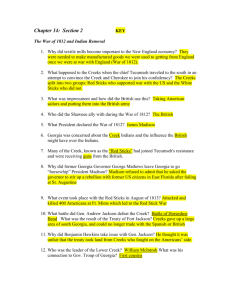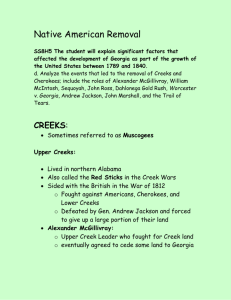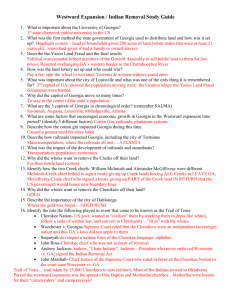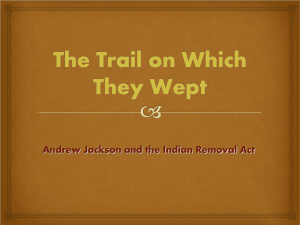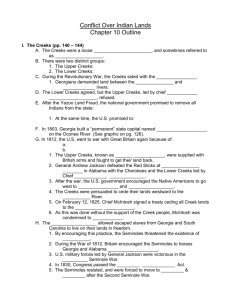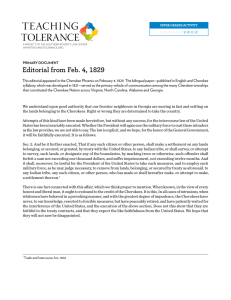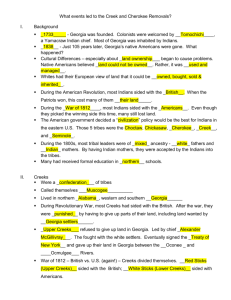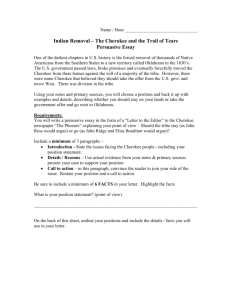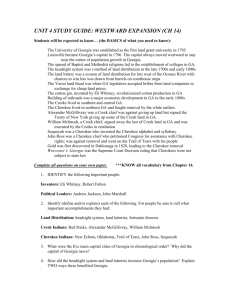Indian Removal in Georgia
advertisement
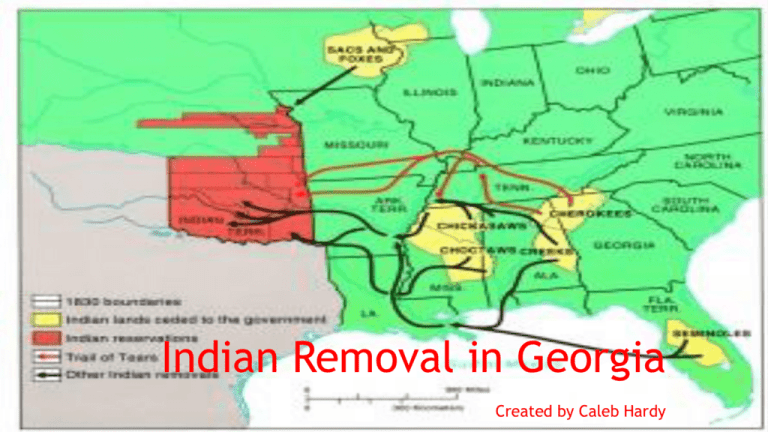
Indian Removal in Georgia Created by Caleb Hardy Creeks (A.K.A. Muskogee’s) • Upper Creeks- lived in towns in upper Alabama • Lower Creeks- lived in towns in western Georgia, southern Alabama and Northern Florida (these Creeks later became known as Seminoles) • The Creek Territory in Georgia was used for hunting (Very Important) • The Muskogee Creeks were given the name Creeks from the Ocmulgee Creek by the white settlers, but soon began to call themselves Muskogee to the Europeans. Conflicts with “White Man” • The Creeks fought on the side of the British during the Revolutionary War. • Once the Patriots won their Independence, Americans thought that they should not have the right to their native land. • Lower Creeks peacefully gave up their land (they are known as White Sticks) • Upper Creeks fought the white invaders fiercely (they are known as Red Sticks) Oconee War • Chief Alexander McGillivray led the Red Sticks to wage a war against the white settlers and others siding with them. • Many Cherokees fought on behalf of the white men • To end the fighting, President Washington invited Chief Alexander McGillivray to New York in 1790. • They signed the Treaty of New York, ending the fighting. • This treaty granted all of the land east of the Oconee River to the whites and all of the land west of the Oconee River to the Creeks. • The Whites were angry that the Creeks were given any land and the Creeks were agitated that the whites were given land; therefore, nobody was happy with this treaty. New Land for Georgians • With the Creeks giving up land – more land was available for White settlers. • After the Treaty of New York (1790), many White families began to come for land. As more and more came, they began to move north and then west. • More people are wanting to own land in Georgia, but there is only so much land to go around. • To decide who would get the land, they performed a land lottery, with the first one beginning in 1803. War of 1812 • Not even three decades after the signing of the Treaty of Paris, which formalized Britain’s recognition of the United States of America, the two countries were again in conflict. • Resentment for Britain’s interference with American international trade, combined with American expansionist visions, led Congress to declare war on Great Britain on June 18, 1812. • Lower Creeks (White Sticks) sided with the United States and did not want to fight. • Upper Creeks (Red Sticks) sided with the British hoping to get their back that they lost in the Treaty of New York. Fort Mims Massacre • On August 30, 1813, more than 1000 Red Sticks attacked Fort Mims, in southern Alabama, killing and scaling 500 innocent white and mixed blood men, women, and children who had fled to the fort for safety. • The Creeks had been armed by the British in Pensacola, FL. • Known as the “Worst Massacre in American History”. Battle of Horseshoe Bend (1814) • American Forces, led by Andrew Jackson, met the Red Sticks at Horseshoe Bend, on the Tallapoosa River, in eastern Alabama. • Fighting alongside Jackson were, Cherokee Indians led by John Ross and Sequoyah, and White Stick Creeks led by William McIntosh. • About 600 Red Sticks were killed. • This defeat led the Red Sticks to give up their land in South Georgia to General Jackson. Chief William McIntosh • His efforts during the Battle of Horseshoe Bend made him a War Hero leading the Creeks to name him Chief of the tribe left in Georgia. • His first cousin was George Troup, who was the Governor of Georgia, and Troup believed that this relationship would lead to the Creeks selling the rest of their land in Georgia. • McIntosh was offered $200,000 to sell the rest of the Creek land in Georgia. • McIntosh approached Cherokee Chief John Ross to sell the Cherokee land as well, but Ross warned the Creeks of the intentions of the White Man. Creek Land Sold • On February 12, 1825, McIntosh took the offer and sold the remaining land in Georgia by signing the Treaty of Indian Springs. • After selling the Creek land, McIntosh was brutally murdered outside his home in Indian Springs. • Watch Georgia Stories: http://www.gpb.org/georgiastorie s/story/story_of_chief_william_m cintosh http://digital.library.okstate. edu/kappler/vol2/treaties/cr e0264.htm Cherokees • The Cherokee Chiefdom consisted of 80 or so towns along rivers and streams in Northern Georgia. In the late 1700’s, the chiefdoms combined in a unified government. • The Cherokees adopted much of the white culture. A Cherokee named Sequoyah created a Syllabary in the early 1800’s, and many Cherokee became teachers and lawyers. • New Echota was the capital. • They established a legislative, executive, and judicial branch, through a constitution. • The Cherokee Phoenix was printed as a bilingual newspaper. • Many Cherokees converted to Christianity as missionaries built churches in their territory. Sequoyah https://www.youtube.com/watch?v=L84GG4hEfts Gold Rush • Benjamin Parks discovered gold in Lick Log, Georgia, while deer hunting, which is now Dahlonega. Parks proceeded to tell everybody and this led to the first Gold Rush in the United States. • The Cherokee controlled most of the land in the gold region. Georgia’s legislature began to plan the removal of the Cherokee immediately after the discovery of gold in their land. • This would eventually lead to the “Trail of Tears”. Indian Removal Act • In 1828, the General Assembly decided to make the Cherokee’s body of laws “null and void”. • As Andrew Jackson took office in 1829, he declared that he would remove all Indians in the Southeast. • The Indian Removal Act was passed by Congress on May 28, 1830. • The law authorized the president to negotiate with southern Indian tribes for their removal to federal territory west of the Mississippi River in exchange for their ancestral homelands. Worcester v. Georgia • Worcester was a Christian Missionary living in the Cherokee Nation. Georgia directed any whites living in the Cherokee territory to sign an oath pledging to uphold the laws of Georgia because the Cherokee had their own set of laws. Worcester said no, was jailed, and took it all the way to the Supreme Court. • Justice John Marshall announced the Supreme Courts decision: Georgia laws did not apply in the Cherokee Nation and Georgia could not detain Worcester, since he lived in the Cherokee Nation. • The Cherokee celebrated, but President Jackson stated, “John Marshall has made his decision; now let him enforce it. John Ross • Like the Creeks, the Cherokee were divided. Many Cherokee followed Chief John Ross and resisted the whites. The others believed that it was best if they went west. • Major Ridge, John Ridge, and Elias Boudinot (Cherokee Leaders) ended up singing the Treaty of New Echota (1835), selling the rest of the Cherokee land for 5 million dollars. They were later killed for selling the land. Trail of Tears • Indian removal began in 1838. • Andrew Jackson forced his adversary, General Winfield Scott, to enforce the removal. • The first parties of Cherokee to leave Georgia suffered huge losses in both people and livestock, attempting to travel west in the scorching heat of summer. • The Cherokee clearly viewed Scott as their “warden,” when they appealed to him to postpone the removal until cooler months, stating, “We, your prisoners, wish to speak to you... We have been made prisoners by your men but do not fight you.” The appeal to Scott worked, and he agreed to postpone the removal. Scott even backed a proposal to allow the departing Indians to be lead by Cherokee Chiefs, rather than by the U.S. Army. For this, Winfield Scott received terrible backlash from the proremoval forces, including former President Andrew Jackson, who wrote to protest Scott’s decision. Hitler later copied Andrew Jackson’s plan of Indian removal in his plans for removal of Jews. Native Americans were virtually wiped out by Jackson. Today, Native Americans make up less than 1.5% of the U.S. population. http://www.gpb.org/georgiastories/videos/trail_of_tears
